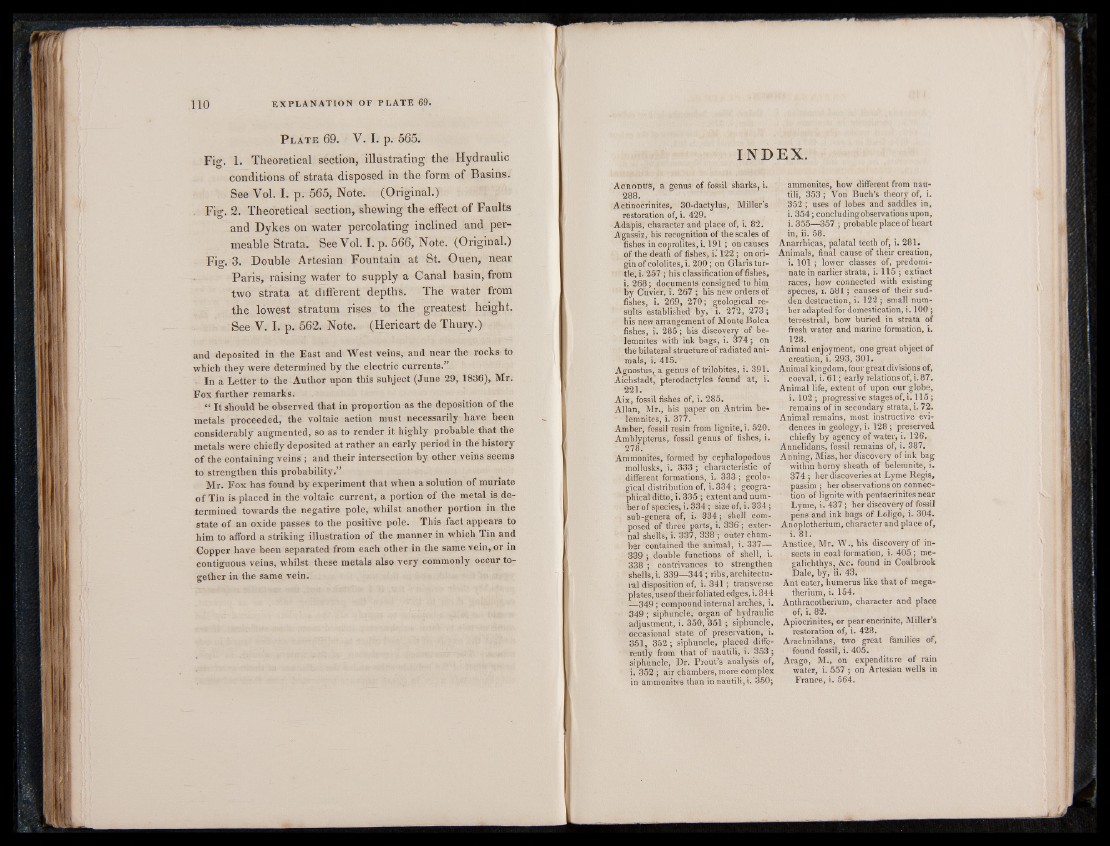
P l a t e 69. V. I. p. 565.
Fig. 1. Theoretical section, illustrating the Hydraulic
conditions of strata disposed in the form of Basins.
See Vol. I. p. 565, Note. (Original.)
. Fig. 2. Theoretical section, shewing the effect of Faults
and Dykes on water percolating inclined and permeable
Strata. SeeVol. I.p. 566, Note. (Original.)
Fig. 3. Double Artesian Fountain at St. Ouen, near
Paris, raising water to supply a Canal basin, from
two strata at different depths. The water from
the lowest stratum rises to the greatest height.
See V. I. p. 562. Note. (Hericart de Thury.)
and deposited in the East and West veins, and near the rocks to
which they were determined by the electric currents.”
In a Letter to the Author upon this subject (June 29, 1836), Mr.
Fox further remarks.
“ It should be observed that in proportion as the deposition of the
metals proceeded, the voltaic action must necessarily have been
considerably augmented, so as to render it highly probable that the
metals were chiefly deposited at rather an early period in the history
of the containing veins ; and their intersection by other veins seems
to strengthen this probability.”
Mr. Fox has found by experiment that when a solution of muriate
of Tin is placed in the voltaic current, a portion of the metal is determined
towards the negative pole, whilst another portion in the
state of an oxide passes to the positive pole. This fact appears to
him to afford a striking illustration of the manner in which Tin and
Copper have been separated from each other in the same vein, or in
contiguous veins, whilst these metals also very commonly occur together
in the same vein.
INDEX.
Acrodus, a genus of fossil sharks, i.
288.
Actinocrinites, 30-dactylus, Miller's
restoration of, i. 429.
Adapis, character and place of, i. 82.
Agassiz, his recognition of the scales of
fishes in coprolites, i. 191 ; on causes
of the death of fishes, i. 1 2 2 ; on origin
of cololites, i. 200 ; on Glaris turtle,
i. 257 ; his classification of fishes,
i. 268; documents consigned to him
by Cuvier, i. 267 ; his new orders of
fishes, i. 269, 270; geological results
established by, i. 272, 273 ;
his new arrangement of Monte Bolca
fishes, i. 285; his discovery of be-
lemnites with ink bags, i. 374; on
the bilateral structure of radiated animals,
i. 415.
Agnostus, a genus of trilobites, i. 391.
Aichstadt,’ pterodactyles found at, i.
221.
Aix, fossil fishes of, i. 285.
Allan, Mr., his paper on Antrim be-
lemnites, i. 377.
Amber, fossil resin from lignite,!. 520.
Amblypterus, fossil genus of fishes, i.
’ 278.
Ammonites, formed by cephalopodous
mollusks, i. 333 ; characteristic of
different formations, i. 333; geological
distribution of, i. 334 ; geographical
ditto,‘17335 ; extent and number
of species, i. 334 ; size of, i. 334 ;
sub-genera of, i, 334; shell composed
of three parts, i. 336 ; external
shells, i. 337, 338 ; outer chamber
contained the animal, i. 337—
339 ; double functions of shell, i.
338 ; contrivances to strengthen
shells,i. 339—344; ribs, architectural
disposition of, i. 341 ; transverse
plates, useoftheirfoliated edges, i. 344
—349 ; compound internal arches, i.
3 4 9 ; siphuncle, organ of hydraulic
adjustment, i. 350, 351 ; siphuncle,
occasional state of preservation, i.
351, 352; siphuncle, placed differently
from that of nautili, i. 353;
siphuncle, Dr. Prout’s analysis of,
i. 352; air chambers, more complex
in ammonites than in nautili, i. 350;
ammonites, how different from nautili,
353 ; Von Buch’s theory of, i.
352 ; uses of lobes and saddles in,
i. 354; concluding observations upon,
i. 355—357 ; probable place of heart
in, ii. 58.
Anarrhicas, palatal teeth of, i. 281.
Animals, final cause of their creation,
i. 101 ; lower classes of, predominate
in earlier strata, i. 115 ; extinct
races, how connected with existing
species, i. 581; causes of their sudden
destruction, i. 122 ; small number
adapted for domestication, i. 1 0 0 ;
terrestrial, how buried in strata of
fresh water and marine formation, i.
128.
Animal enjoyment, one great object of
creation, i. 293, 301.
Animal kingdom, four great divisions of,
coeval, i. 61; early relations of, i. 87.
Animal life, extent of upon our globe,
i. 102 ; progressive stages of, i. 115;
remains of in secondary strata, i. 72.
Animal remains, most instructive evidences
in geology, i. 128 ; preserved
chiefly by agency of water, i. 126.
Annelidans, fossil remains of, i. 387.
Anning, Miss, her discovery of ink bag
within horny sheath of belemnite, i.
374 ; her discoveries at Lyme Regis,
passim ; her observations on connection
of lignite with pentacrinitesnear
Lyme, i. 437 ; her discovery of fossil
pens and ink bags of Loligo, i. 304.
Anoplotherium, character and place of,
i. 81.
Anstice, Mr. W., his discovery of insects
in coal formation, i. 405 ; me-
galichthys, &c. found in Coalbrook
Dale, by, ii. 43.
Ant eater, humerus like that of megatherium,
i. 154.
Anthracotherium, character and place
of, i. 82.
Apiocrinites, or pear encrinite, Miller’s
restoration of, i. 428.
Arachnidans, two great families of,
found fossil, i. 405.
Arago, M., on expenditure of rain
water, i. 557 ; on Artesian wells in
France, i. 564.